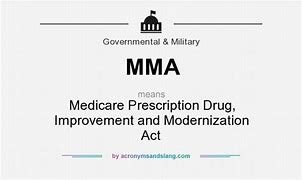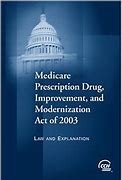
Medicare, Prescription Drugs, Modernization: A thorough Guide
The Medicare Prescription Drug, Improvement, and Modernization Act of 2003 (MMA) is a landmark piece of legislation that significantly reshaped the Medicare program. This act introduced a new prescription drug benefit, made improvements to existing Medicare programs, and addressed various issues related to fraud and abuse. This article will offer a thorough overview of the MMA, exploring its key components, its impact, and its ongoing relevance.
What is the Medicare Prescription Drug, Improvement, and Modernization Act of 2003?
The Medicare Prescription Drug, Improvement, and Modernization Act of 2003, commonly known as MMA, is a federal law that expanded the Medicare program to include prescription drug coverage. This act was passed by Congress and signed into law by President George W. Bush in December 2003.
What is Medicare?
Related Post : title vii of the civil rights act of 1964 quizlet
Medicare is a federal health insurance program that offers coverage for individuals aged 65 and older, as well as younger individuals with certain disabilities. It is funded through payroll taxes and general revenue. Medicare is divided into four parts:
- Part A: Hospital insurance
- Part B: Medical insurance
- Part C: Medicare benefit, which offers private health insurance plans
- Part D: Prescription drug coverage, which was added by the MMA
What are Prescription Drugs?
Prescription drugs are medications that can only be obtained with a prescription from a doctor or other licensed healthcare professional. These drugs are intended to treat specific medical conditions and require careful monitoring to ensure safety and efficacy.
What does "Modernization" mean in this context?
The “Modernization” facet of the MMA refers to the act’s intention to modernize and improve the Medicare program. This includes streamlining administrative processes, enhancing beneficiary access to information, and implementing technological advancements.
Why was this Act Necessary?
The rising costs of prescription drugs were a significant concern for Medicare beneficiaries. Many seniors struggled to afford their medications, leading to health complications and potentially reducing their quality of life. The MMA aimed to address this issue by providing prescription drug coverage through a new benefit plan, Part D.
What are the Major Components of the Act?
The MMA consists of several key provisions that aim to improve Medicare and address the challenges related to prescription drug coverage. Here are some of the major components:
Part D: The Prescription Drug benefit
- What is Part D? Part D is a voluntary prescription drug benefit that is available to all Medicare beneficiaries. It offers coverage for a wide scope of prescription medications.
- How does Part D work? Part D operates through private insurance companies that offer various plans. Beneficiaries can select the plan that optimal meets their needs and budget.
- Who is eligible for Part D? All Medicare beneficiaries are eligible to enroll in Part D.
- How do I enroll in Part D? Enrollment in Part D is an annual process that takes place during a specified period. Individuals can enroll online, by phone, or through a Medicare-approved broker.
- What are the varied types of Part D plans? There are various types of Part D plans available, each with varied coverage levels, formularies (lists of covered drugs), and costs.
- What are the costs associated with Part D? Part D plans typically require a monthly premium, a deductible, and copayments or coinsurance for each prescription filled.
- How do I select the right Part D plan for me? When choosing a Part D plan, consider factors such as:
- Your medications and their costs
- Your budget
- Your preferred pharmacy network
- The plan’s formulary (list of covered drugs)
Other Key Provisions of the Act
- Medicare benefit (Part C): The MMA expanded the Medicare benefit program, which offers private health insurance plans as an alternative to traditional Medicare.
- Medicare Improvements: The act included provisions to improve Medicare administrative processes, enhance beneficiary access to information, and implement technological advancements.
- Prescription Drug Pricing Negotiations: The MMA authorized the Secretary of Health and Human Services to negotiate prices for certain drugs used by Medicare Part D beneficiaries.
- Fraud and Abuse Prevention: The act strengthened fraud and abuse prevention measures to protect the Medicare program from fraudulent claims.
- Outreach and Education: The MMA mandated boostd outreach and education efforts to inform beneficiaries about their Medicare options and the new prescription drug benefit.
The Impact of the Act
The MMA has had a significant impact on Medicare beneficiaries and the healthcare landscape in general. Here’s an examination of its effects:
- How has the Act affected Medicare beneficiaries? The MMA offerd access to prescription drug coverage for millions of Medicare beneficiaries who earlier struggled to afford their medications. This has led to improved health outcomes and quality of life for many seniors.
- What are the pros and cons of the Act? The MMA has been both praised and criticized for its impact on the Medicare program. Some argue that the act has effectively addressed the need for prescription drug coverage, while others criticize its complexity and potential for higher costs.
- Has the Act been achievementful in achieving its objectives? The MMA has been achievementful in providing access to prescription drug coverage for millions of Medicare beneficiaries. However, the act has also been criticized for its high costs and complexity.
- What are the future challenges facing Medicare and prescription drug coverage? As the population ages and healthcare costs continue to rise, the future of Medicare and prescription drug coverage will remain a critical issue.
Conclusion
The Medicare Prescription Drug, Improvement, and Modernization Act of 2003 has been a major piece of legislation in the history of Medicare. This act has had a profound impact on millions of Americans. This article has offerd an overview of the act’s key provisions, its impact, and some of the challenges it faces. As the population ages and healthcare costs continue to rise, the future of Medicare will remain a critical issue.

Leave a Reply